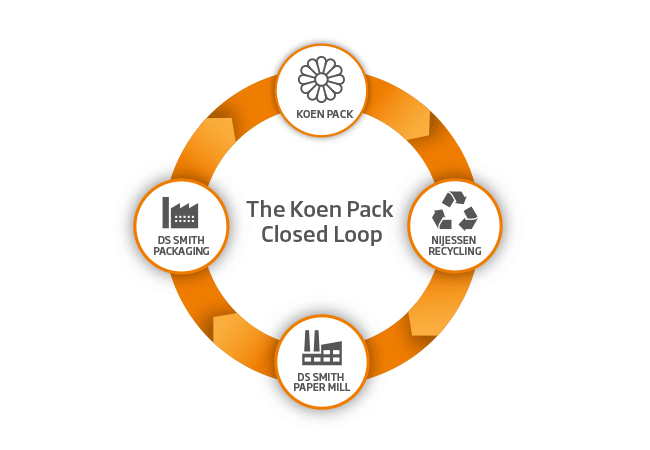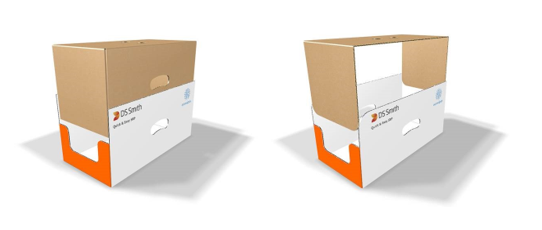Three times we applied the three key principles of the Circular Economy
At DS Smith, making the transition from the Linear to the Circular Economy is core to our purpose of Redefining Packaging for a Changing World. By adopting circular ideas, we can create a more sustainable world for now and for future generations.
As a Strategic Partner of the Ellen MacArthur Foundation, we understand just how important it is to apply the three core principles of the Circular Economy within our business model;
- Keeping products and materials in use
- Designing out waste and pollution
- Regenerating natural systems
As we continue our journey to lead the transition to the Circular Economy, we take a look back over the last year, and reflect on three moments when we successfully applied the three core principles of the Circular Economy.
1. How we’re keeping products and materials in use

Currently our economic systems are linear, built on a model that takes natural resources, makes them into products and then disposes of them.
We can’t keep wasting resources. Products and materials must be kept in the economy. Our closed-loop model ensures our customers’ cardboard waste is collected, recycled and then used again to make new boxes. This process can be repeated up to 25 times.
Here’s a great example of how we’re helping to keep products and materials in use for longer.
Closing the loop with Koen Pack
The Challenge:
Koen Pack is a global specialist supplier of flowers and plant packaging. Like us, they have a vision to create a more sustainable world, and better waste management plays an integral part in delivering it.
The Solution:
Koen Pack joined our closed loop recycling model for its Dutch operations. Through our closed loop model we can ensure its cardboard waste is collected, recycled and then used again to make new boxes.

To optimise transport efficiency, we worked with a trusted local recycling partner, Nijssen Recycling. Under our fully auditable and traceable solution, Nijssen Recycling collects cardboard recycling from Koen Pack’s plant in Amstelveen and bales it. We then collect the bales from Nijssen as part of our regular weekly collection. These are taken to our De Hoop paper mill and used to make recycled brown liners. The liners are then manufactured into new boxes.
The Benefits:
Materials are kept in use for as long as possible, reducing the need for virgin materials and ultimately limiting excessive consumption of natural resources. With our support, Koen Pack is recycling fibre and keeping around 5,000 tonnes of packaging in the supply cycle per year.
Read more about our closed loop collaboration with Koen Pack here.
2. How we’re designing out waste and pollution

Did you know that waste and pollution are largely a result of the way we design things? Waste and pollution are not accidents, but the consequences of the decisions made at the design stage, are where around 80% of the environmental impacts are determined.
Circularity principles disclose and design out the negative impacts of economic activity that cause damage to human health and natural systems. This includes the release of greenhouse gasses and hazardous substances, the pollution of air, land and water as well as structural waste such as traffic congestion.
We use our Circular Design Principles and innovation teams to create packaging solutions that shorten and simplify supply chains. Here’s a great recent example of how we are designing out waste and pollution whilst delighting our customers.
DS Smith helps ECOWipes to reduce CO2 emissions by 10% and costs by 30%
The Challenge:
ECOWipes is a manufacturer of nonwovens, mainly used in children's, cosmetic, hygienic and household products.
We conducted an audit of its production line and identified numerous opportunities to give the customer cost savings on its Shelf Ready Packaging (SRP), while designing out waste.
The Solution:
Our experts identified two potential savings by applying better design to the top and bottom lid of ECOWipes SRP.
- The Lid
The existing very strong structure is glued to the full height. We changed it to a U-type lid which resulted in a reduction of raw material consumption by 60%, from 0.37 m2 to 0.15 m2.
Before After
- The Bottom
On the bottom we shortened one of the flaps, rather than it being the full length . This small change resulted in a reduction in the consumption of raw materials by 18% from 0.48 m2 to 0.39 m2.
Before After 
The Benefits:
The cost of the packaging itself was 32% lower and in addition our changes led to a 10% reduction in CO2 emissions.
By reducing the amount of raw material used in the packaging, the customer also achieved cost reductions in inbound logistics by 32%, the packaging line by 17%, storage by 33% and recycling by 40%. This has resulted in costs being reduced by 30% throughout the supply chain.
3. How we’re regenerating and renewing natural systems

A circular economy avoids the use of non-renewable resources and preserves or enhances renewable ones. But, what if we could not only protect, but actively improve the environment?
In nature, there is no concept of waste. Everything is food for something else, for instance, a leaf that falls from the tree feeds the forest. Instead of simply trying to do less harm, we should aim to do good. By returning valuable nutrients to the soil and other ecosystems, we can enhance our natural resources.
One of the targets from our Now and Next Sustainability Strategy seeks to do this by funding 100 biodiversity projects by 2025; with the DS Smith Charitable Foundation pledging £100,000 to this cause.
Below is a great example of a biodiversity project which is helping to regenerate and renew natural systems.
Launceston Community Forest supports the natural environment
The Challenge:
Sam Virgo-Brown, Transport Manager at our Launceston site in the UK set out on a journey to see what green space opportunities were available near the site. Within six months the Launceston Community Forest was founded and an area for development was identified close to the site.
The Solution:
With funding from the DS Smith Charitable Foundation, the project aims to improve local biodiversity, protect native species and create a new area for the community to enjoy, in a 12 acre woodland owned by Cornwall Council.
The Benefits:
DS Smith volunteers will help to plan and implement the initial phases of development, using the £1,000 grant to help to:
- Reintroduce plant species by creating flower meadows and developing habitats for native animals and insects.
- Create footpaths, including wheelchair friendly routes and picnic areas, so that the local community can enjoy the delights of nature.
- Clear the woodland and make it safe to use for the local community.
Learn more about the Launceston Community Forest Project here
